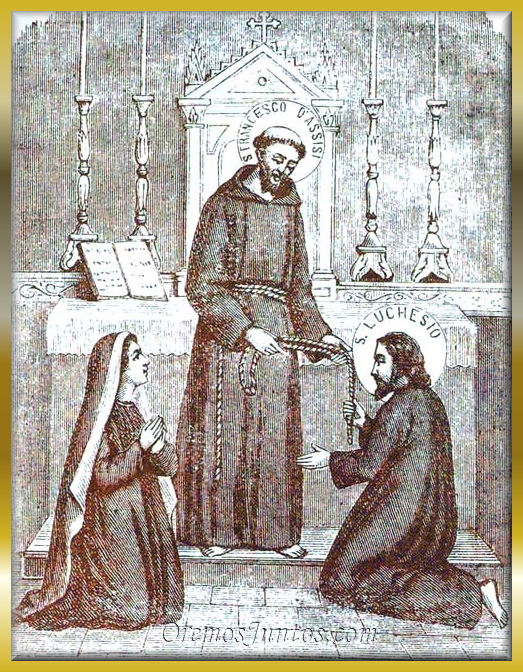Blessed Luchesio and Buonadonna
On April 28, the Church celebrates the memorial of blessed Luchesio, who has been traditionally
considered as the first member of the Third Order of Saint Francis, along with his wife Buonadonna. However, we still can keep their spiritual legacy in mind and reflect on it since it represents some of the origins of what we now call the Secular Franciscan Order. Celebrating our new life in Christ during Easter time also nourishes our desire to renew our Franciscan way of life, which shines through the example of all of our holy ancestors of the Franciscan family.
The earliest hagiographical sources on Luchesio and Buonadonna are late (XIV and XV centuries) and have come to us with very clear signs of being reworked in order to adjust to hagiographical styles of the time and place of origin. Luchesio was born in Gaggiano, Chianti, around the years 1180-1200, in a family of peasants. He married Buonadonna, from a wellto-do family of Borgo Marturi, and they had several children. He got involved in politics and became the leader of one of the political parties in Tuscany. Because the political environment became very agitated, the family decided to move to Poggibonsi, where Luchesio skillfully devoted himself to commercial activities and became rich and avaricious. Continue reading after advertising
They suffered the loss of their children and towards the year 1220 Luchesio’ life had a dramatic change when, touched by grace, he set his heart and mind on seeking the treasure of God’s kingdom. Fascinated by the well-known example and the gospel values of St. Francis of Assisi, whom he probably met in 1221, he embraced the penitential state of life, devoting himself to intense prayer, fasting, and to share his possessions with the poor.
According to the tradition, Buonadonna was not initially supportive of Luchesio’ largesse, but some signs of God’s Providence convinced her to join him wholeheartedly in such a path. As they advanced in their conversion, they gave up all their possessions except for a small portion of land that Luchesio cultivated for their own sustenance and to assist the poor. This choice for voluntary poverty seems to be proved by a historic document that attests to the sale of Buonadonna’s house, dated on August 7, 1227 and carried out with both spouses’ consent. Luchesio’ generosity was also shown in his caring for the sick at the hospital in Poggibonsi. Continue reading after advertising
After conducting a fruitful penitential life for many years, both spouses became ill and died within a few hours of each other, according to some sources, on April 28, 1241 (according to others in 1260). They had previously received sacramental assistance from the guardian of the Friars Minor’s in Poggibonsi, in whose chapel they were both buried. Local veneration began soon after and, as the popular devotion kept growing, the church was expanded and dedicated to St. Francis and to the blessed Luchesio. Through the centuries, many miracles have been attributed to the intercession of this married couple.
The feast of Luchesio was made solemn by the township of Poggibonsi in 1331 when he became the town’s patron saint along with St. Lawrence. Even though Buonadonna was not officially given the title of ‘blessed’, the local tradition named her as such. Luchesio was beatified by Pope Innocent XII on March 27, 1697 and his veneration was confirmed by Pope Gregory XVI on August 23, 1883. Even if there is not enough historic evidence to sustain that Luchesio and Buonadonna were the very first members of the Third Order of St. Francis, their lives clearly reflect a true penitential spirit and represent some of the earliest fruits of Franciscan holiness in the secular state. Continue reading after advertising
Luchesio and Buonadonna’s testimony helps us to remember how the Franciscan way of life emerges from the sincere conversion to the gospel of Jesus Christ, which enriches us with the treasure of God’s kingdom and sets us free from selfish attachment to material possessions. This ongoing conversion enables us to serve our brothers and sisters – especially the poor and the suffering – sharing generously with them our gifts, talents and time. This memorial also points out the importance of carrying out the Franciscan values in the temporal realities, putting into practice our faith and love in the family and in society by integrating contemplative prayer and sacramental life with active love for our neighbor, caring for the sick, living with solidarity with the poor – in whom we also see Christ – and adopting a way of life marked with simplicity and honest work.
Fr. Amando Trujillo Cano, TOR





Comments
Post a Comment